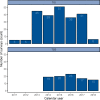The costs of monitoring trachoma elimination: Impact, surveillance, and trachomatous trichiasis (TT)-only surveys
- PMID: 31487281
- PMCID: PMC6728015
- DOI: 10.1371/journal.pntd.0007605
The costs of monitoring trachoma elimination: Impact, surveillance, and trachomatous trichiasis (TT)-only surveys
Abstract
Background: Although trachoma causes more cases of preventable blindness than any other infectious disease, a combination of strategies is reducing its global prevalence. As a district moves toward eliminating trachoma as a public health problem, national programs conduct trachoma impact surveys (TIS) to assess whether to stop preventative interventions and trachoma surveillance surveys (TSS) to determine whether the prevalence of active trachoma has rebounded after interventions have halted. In some contexts, programs also conduct trachomatous trichiasis (TT)-only surveys. A few costing studies of trachoma prevalence surveys exist, but none examine TIS, TSS, or TT-only surveys.
Methodology/principal findings: We assessed the incremental financial cost to the national program of TIS, TSS, and TT-only surveys, which are standardized cluster-sampled prevalence surveys. We conducted a retrospective review of expenditures and grant disbursements for TIS and TSS in 322 evaluation units in 11 countries between 2011 and 2018. We also assessed the costs of three pilot and five standard TT-only surveys in four countries between 2017 and 2018. The median cost of TIS and TSS was $8,298 per evaluation unit [interquartile range (IQR): $6,532-$10,111, 2017 USD]. Based on a linear regression with bootstrapped confidence intervals, after controlling for country, costs per survey did not change significantly over time but did decline by $83 per survey implemented in a single round (95% CI: -$108 --$63). Of total costs, 80% went to survey fieldwork; of that, 58% went towards per diems and 38% towards travel. TT-only surveys cost a median of $9,707 (IQR: $8,537-$11,635); within a given country, they cost slightly more (106% [IQR: 94%-136%]) than TIS and TSS.
Conclusions/significance: The World Health Organization requires trachoma prevalence estimates for validating the elimination of trachoma as a public health problem. This study will help programs improve their planning as they assemble resources for that effort.
Conflict of interest statement
The authors have declared that no competing interests exist.
Figures



References
-
- WHO. Validation of elimination of trachoma as a public health problem [Internet]. 2016 Jun. Report No.: WHO/HTM/NTD/2016.8. Available: http://www.who.int/trachoma/resources/who_htm_ntd_2016.8/en/
-
- WHO Strategic and Technical Advisory Group on Neglected Tropical Diseases. Technical consultation on trachoma surveillance September 11–12, 2014, Task Force for Global Health, Decatur, USA: [Internet]. Geneva: WHO; 2015 Jul. Report No.: WHO/HTM/NTD/2015.02. Available: https://www.who.int/trachoma/resources/who_htm_ntd_2015.02/en/
Publication types
MeSH terms
Grants and funding
LinkOut - more resources
Full Text Sources
Research Materials

